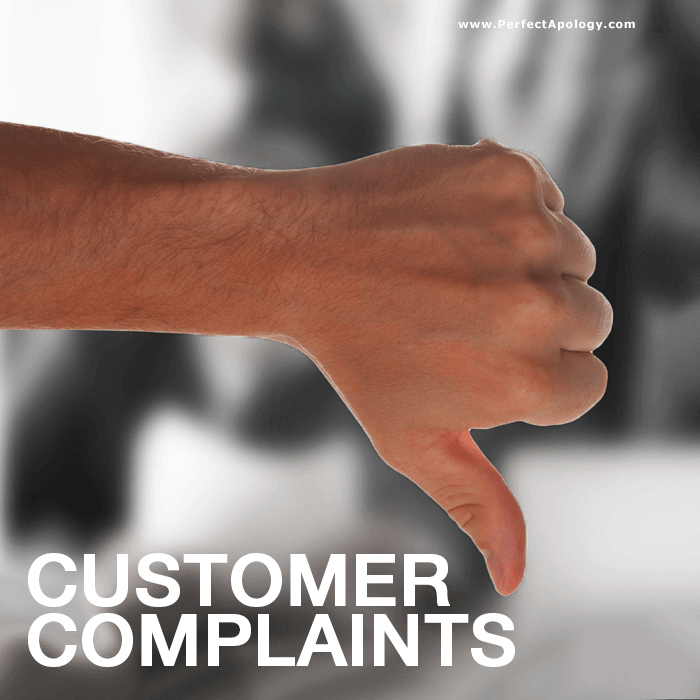How to Handle Customer Complaints
How to handle customer complaints is the most common question we hear when it comes to business apologies.
What should a company do, say or avoid to retain customers? What steps or procedures should be taken to solve current problems and avoid future ones?

The emails we receive on the topic are predominantly from the people on the front lines who've received no guidance on how to manage the situation, or who have managers committed to traditional approaches despite the costs or consequences.
The Cost of Unchecked Negative Customer Feedback
The fact that so many employees (across various industries) continually seek our advice when handling customers complaints or when trying to craft their own perfect apologies suggests that many organizations still don't appreciate the costs of negative customer feedback, and the value of effective customer communications for their bottom line.
That bottom line will not only end up suffering from a potential poor reputation spreading off- and online but more importantly through decreased customer retention.
So, the first step for any organization is to have a documented customer complaint procedure. While the procedure itself can be quite simple, the benefits it will provide will be felt throughout the organization.
A systematic accounting of each complaint, along with the response and reaction, is essential to improving overall customer experience, relations, and customer retention.

Benefits of Tracking Customer Complaints
For customers, a careful and consistent tracking of complaints and procedures shows a level of professionalism and conveys to clients that their complaints are taken seriously.
For employees, it provides a road map, a set of standard operating procedures, and demonstrates management support for those on the front lines. It also empowers staff to handle situations more confidently, efficiently and effectively.
For management, it identifies potential weaknesses and, more importantly, opportunities for improvement.
Customer Complaints Procedure
The general guidelines for any procedure dealing with customer complaints are as follows:
1. Make it easy for customers to be heard. Whether online, over the telephone or in person, make sure that your customers can easily voice their complaint—without having to wait. Finding it difficult to contact the right person will only add to their frustration and dissatisfaction.
2. Listen carefully to what the customer is expressing and give them (and their complaint) your undivided attention.
Don't interrupt them (if the complaint is being given in person); don't presume you understand their complaint (based on prior experience) before they've had a chance to fully explain their problem; and don't re-interpret their complaint based on what you think their problem is.
And do not simply scan written communications—read every word of the letter to understand the issues from their perspective.
Once they have expressed themselves, follow up by asking if there is anything else that needs to be addressed.
Agree with the customer that a problem is real and relevant—don't dismiss or disagree, and never argue.
3. Apologize. Extend a perfect business apology.
4. Resolve the issue. Ensure that your staff is empowered with the tools required to resolve the matter. Define clear written guidelines for compensation/restitution as appropriate. It's important that your staff are able to quickly act on a complaint.
Once the issue is resolved, ask the customer again whether there is anything else that needs to be discussed.
5. Thank the customer for bringing the matter to your attention, and for improving the quality of a product or service.
6. Document the entire incident for internal use and analysis.
Empower Customer Service On How To Respond To Customer Complaints
Customer service personnel (or anyone dealing with customer feedback) need to be trained on how to respond to customer complaints by laying out the procedures to follow—this is a critical first step.
Employees need to know the steps to take, how to communicate an effective business apology, and what tools are at their disposal to resolve the issue.
IMPORTANT: Make sure that each complaint is documented in a standardized format for internal purposes and analysis.
Identifying patterns can help identify weaknesses in an organization's products and services, as well as, policies and procedures.
A clearly defined customer complaint procedure will empower staff to handle a situation professionally, effectively, in a timely manner, and will have significant impact on a company's customer retention rate.
What is Customer Retention?
In simplest terms, customer retention measures a company's ability to keep customers over a certain period of time.
High customer retention means a company is able to satisfy the needs of its customers (through its products, services and customer support) to the point where they don't seek an alternative business or completely abandon their use of that product or service.
Customer Retention Strategies & Customer Complaints
Customer retention strategies are important to any large or small business. It's commonly known that it's much easier to sell something to an existing customer than acquire a new one.
So why aren't company's making more effort in retaining customers? And why aren't customer complaints viewed as an opportunity to build effective customer retention strategies?
Improving Customer Retention
The first thing we need to understand is that customer retention isn't built solely on satisfaction; it's formed primarily on relationships—and like any successful relationship, respect and trust are fundamental. And, customer complaints provide the ideal opportunity to help build and solidify those existing customer relationships.
Respect and trust come from how we conduct and manage our daily business relationships, especially in difficult circumstances (where apologies often come into play), and through the customer service that we provide. Unfortunately, our first instinct when faced with a customer complaint is to view the situation negatively, which is usually the last thing we should do.
Instead, these 'crises' should almost always be viewed as an opportunity—a positive step towards customer retention.
This is not only true for customers who voice their complaints but even more so for the many customers who experience a problem but don't complain. Many of whom will be looking to take their business elsewhere without warning. As Bill Gates once said,
Your most unhappy customers are your greatest source of learning.
Customer complaints should always be accepted, encouraged and welcomed as an opportunity to learn and build-on existing and potential business relationships.
Unhappy customers should become part of a proactive customer-centric business philosophy—a business strategy that develops and refines effective complaint procedures, recovery policies, and successful customer retention programs.
Customer Retention & Apologies
Apologies can be pivotal in customer retention by immediately addressing customers' concerns while earning their respect and trust.
The three primary elements of good business apologies that speak directly to customer loyalty and retention are:
1 | Ownership/responsibility for the mistake
2 | Some meaningful compensation/restitution
3 | An explanation of how the problem will be fixed
Accepting full responsibility when apologizing for an error or inconvenience is key, followed by a clear, credible and quick solution, and then some form of restitution that lets the customer know they are valued.
In regard to addressing the issue itself, it's critical that the customer be satisfied that the plan you've laid out will prevent any future recurrence.
The most important thing in terms of restitution is how it is perceived by the customer. This might translate into a dollar value or a more convenient way for your customer to patronize your business in the future. Either way, it's important to know how the compensation is viewed by your customer.
Customer Complaints, Retention & Your Bottom Line
A customer who feels valued is more likely to translate those positive feelings into remaining a loyal customer and, more importantly will become an advocate for your business which, in turn, will have an ongoing positive impact on your bottom line.
Creating and developing customer retention strategies and programs that include customer complaint procedures with detailed guidelines (especially for issuing apologies) is one of the most effective means of building customer loyalty.
The guidelines should include among other items, information on when and how to apologize; what wording to use under various conditions; and what forms of restitution are available for specific types of situations. Adequate training on the use and execution of the guidelines should be part of the process.
These types of policies and related guidelines will also foster within your company a customer retention culture that stakeholders (employees, partners, customers) will find very appealing.
As a result, customer retention strategies will be further entrenched throughout the company through a heightened awareness and appreciation of customer complaints that spans from the front desk clerk to the executive suites.
Welcoming customer complaints, understanding their benefits, and having policies in place to deal with them sets a solid foundation for an effective customer retention strategy and program.
Learn how the customer experience is critically important to your business or explore other facets of business apologies.


